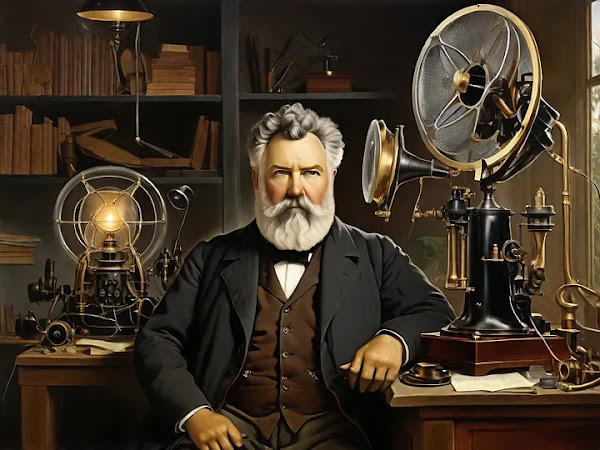In the world we live in today, connection is instant. A single tap on a smartphone can reach across oceans and time zones. But this was not always the case. At the heart of this evolution in communication lies one brilliant mind—Alexander Graham Bell. His groundbreaking invention, the telephone, didn't just change how people communicate—it transformed the entire planet.
Who Was Alexander Graham Bell?
Alexander Graham Bell was born on March 3, 1847, in Edinburgh, Scotland. From a young age, Bell was fascinated by sound and speech. This passion was deeply influenced by his family background—his father and grandfather were both experts in elocution and speech correction. Bell himself began working with the deaf, including teaching Helen Keller, which only deepened his understanding of how humans produce and perceive sound.
Bell's obsession with transmitting sound mechanically set the stage for one of the greatest inventions in history. What began as an interest in helping the hearing impaired grew into an idea that would revolutionize communication forever.
The Race to Invent the Telephone
Bell wasn’t the only person working on transmitting voice over wires. Inventors like Elisha Gray and Antonio Meucci were also in pursuit of a similar goal. However, it was Bell who successfully filed the first telephone patent on March 7, 1876. Just a few days later, he made the world’s first telephone call to his assistant, Thomas Watson, uttering the now-famous words: "Mr. Watson, come here, I want to see you."
This moment wasn't just a technological milestone—it was a turning point in human history. It proved that sound could be transmitted across wires, and more importantly, that people could connect across distances in real time.
How the First Telephone Worked
The first version of Bell’s telephone was incredibly simple compared to modern devices. It used a liquid transmitter and a receiver. Sound waves would cause a diaphragm to vibrate, altering an electric current in the liquid. These changes were transmitted as electrical signals, which would then be converted back into sound at the receiver.
While crude, the concept worked. Over time, Bell and other engineers refined the design, improving audio clarity, range, and reliability. This simple device laid the foundation for what would eventually become the global communication systems we use today.
The Impact of the Telephone on the World
The telephone quickly gained popularity, first in business and then in households. By the end of the 19th century, telephone lines stretched across major cities in the United States and Europe. In 1877, the Bell Telephone Company was established, which later evolved into AT&T.
Here are a few ways the telephone reshaped society:
- Faster Business Communication: Deals could be closed in minutes, not days.
- Emergency Response: Help could be summoned quickly, saving lives.
- Global Connection: Long-distance calling connected continents and cultures.
- Job Creation: Entire industries grew around installation, maintenance, and operation.
Challenges and Controversies
Bell’s invention wasn’t without controversy. Elisha Gray claimed he had developed a similar device and filed a caveat (a form of patent notice) on the same day as Bell. This led to years of legal battles, but Bell’s patent held up in court. Antonio Meucci, an Italian inventor, also demonstrated a similar device years earlier, but failed to file a formal patent due to financial difficulties.
While the debates continue, most historians credit Bell for being the first to successfully patent and commercialize the telephone.
Interesting Facts About Alexander Graham Bell
- Bell considered the telephone an interruption and refused to have one in his office.
- He also invented devices to help the deaf, including the audiometer.
- Bell founded the journal Science and helped establish the National Geographic Society.
- He experimented with flying machines and hydrofoils later in life.
How Bell’s Invention Evolved Over Time
Bell’s invention didn’t stop at the basic model. Over the next century, the telephone underwent massive transformation:
- Rotary Dial Phones: Introduced in the 1920s for more user-friendly dialing.
- Push-Button Phones: Replaced rotary dials in the 1960s and 70s.
- Cordless Phones: Gave people freedom to move while talking in the 1980s.
- Mobile Phones: In the 1990s, communication left the home and went everywhere.
- Smartphones: Today’s phones are powerful computers, thanks to Bell’s original vision.
The Legacy of Alexander Graham Bell
Today, we live in a world where a single device lets us talk, text, stream, and share in real time. It’s easy to forget how incredible this truly is. Bell’s invention sparked a chain reaction of technological advancement that continues to shape our daily lives.
His legacy isn’t just the device itself, but the idea of staying connected. In emergencies, celebrations, work, and love—his invention continues to play a central role in how we live.
Why the Telephone Still Matters Today
Even with the rise of apps and messaging platforms, the core concept of voice calling remains vital. The ability to hear someone’s voice in real time builds trust, emotion, and clarity. In many situations—whether personal or professional—there’s still no substitute for a phone call.
From remote villages to corporate skyscrapers, Bell’s invention continues to bridge gaps. His dream of sound traveling across space not only came true—it became something we can’t live without.
Conclusion: The Man Who Connected the World
Alexander Graham Bell didn’t just invent a machine. He created a future. A future where distance didn’t matter as much. A future where your voice could cross mountains, oceans, and borders in seconds.
Every time your phone rings or your voice reaches someone far away, you’re part of Bell’s incredible legacy. His invention didn’t just change communication—it changed humanity.
And it all began with one sentence: "Mr. Watson, come here, I want to see you."
Written by Uzoid – Exploring the minds and machines that shaped our world.





0 Comments